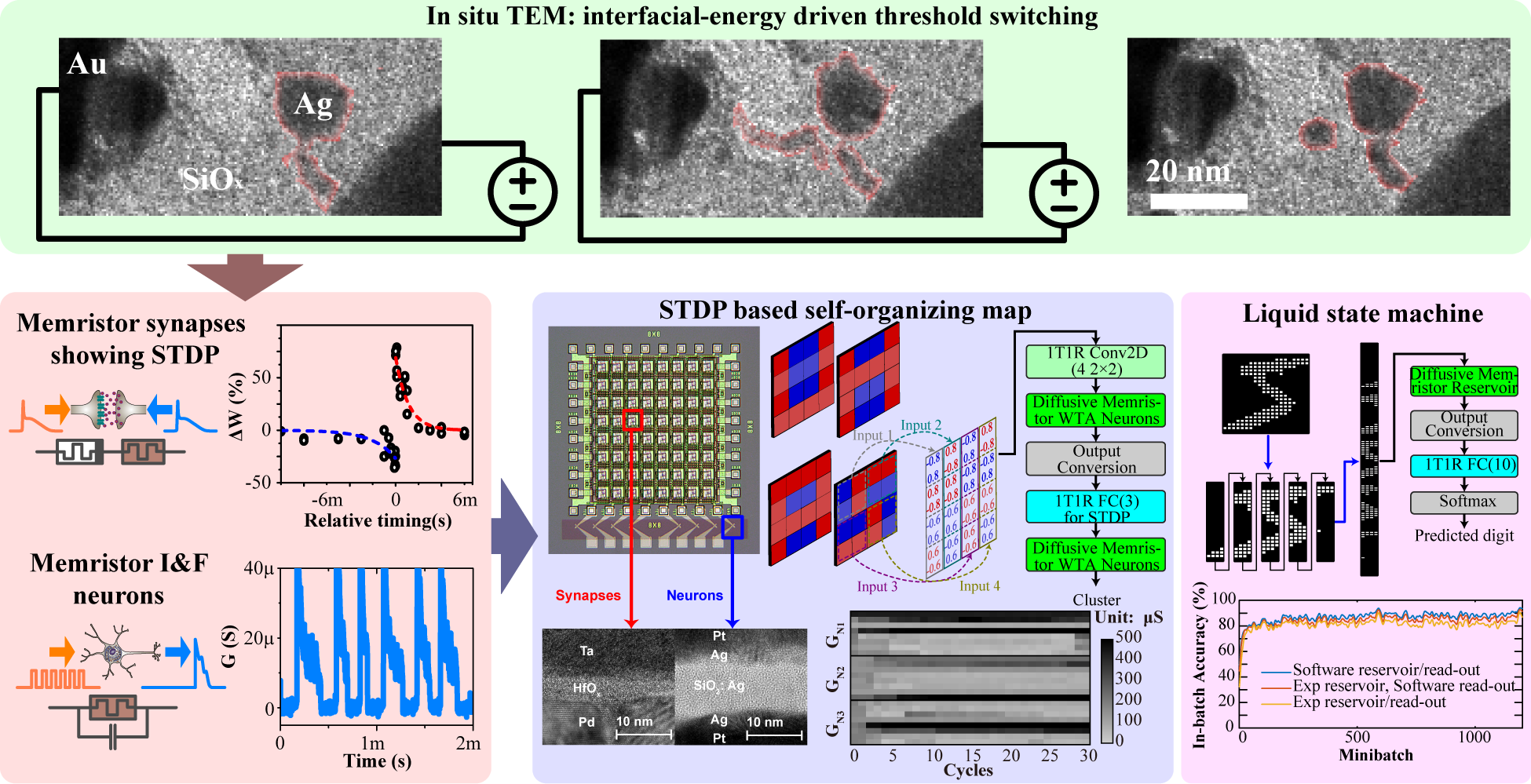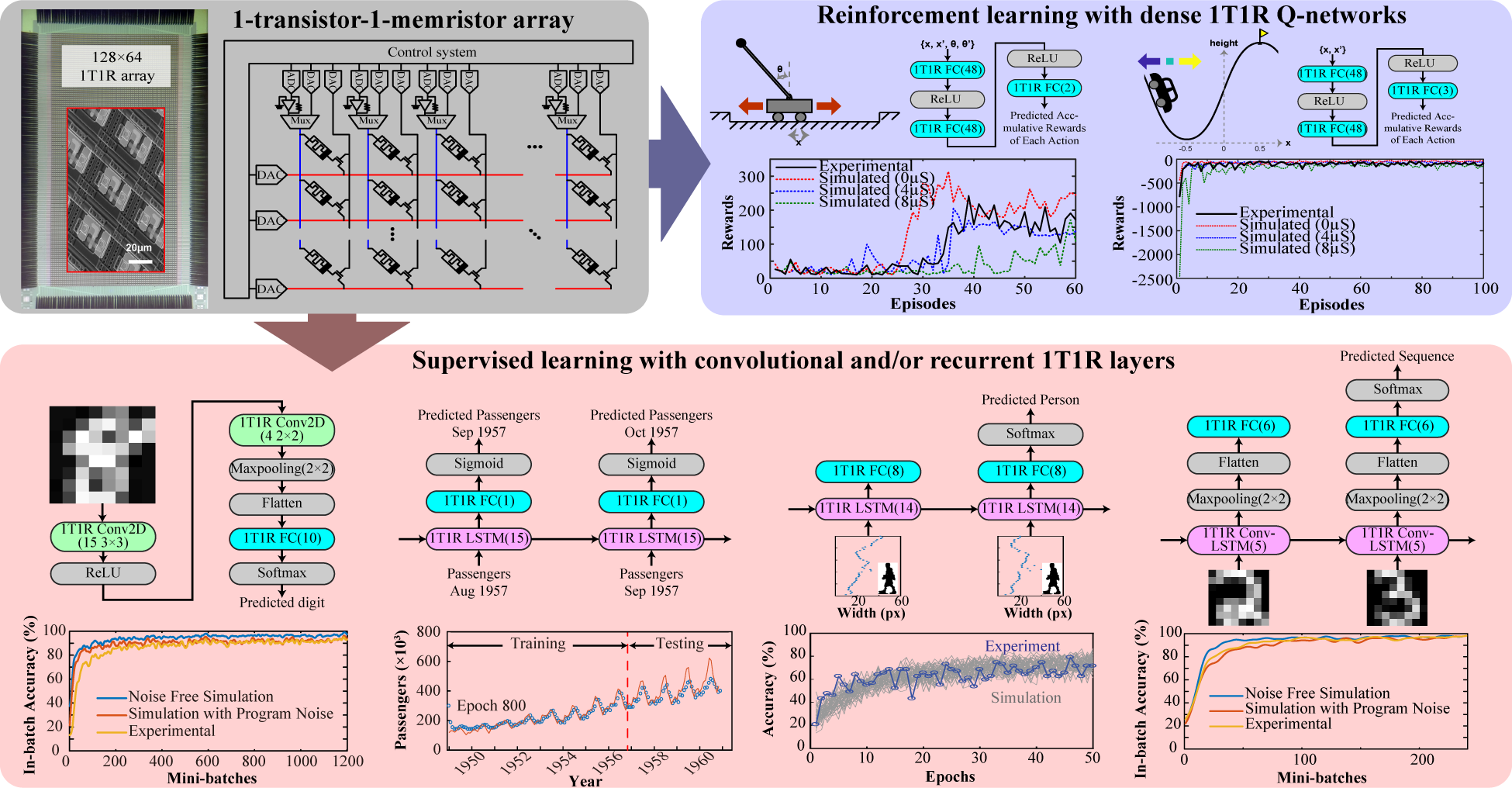Research highlight
Making computers human-like is one of the ultimate goals of electrical and computer engineers. So far, the AI development has been fueled by the advancement of hardware such as GPUs. The performance boost, on one hand due to specialized architecture, on the other hand is driven by the transistor scaling that is difficult to sustain its pace for sub-5nm nodes. Meanwhile, the increase in big data workloads, in part due to the IoTs, are driving computing increasingly data-centric, posing another challenge to von Neumann machines, since frequent data shuttling between the physically separated processing and memory units limits the energy efficiency and data bandwidth.
The focus of my research is to address this challenge by computing with the emerging electronic memory (e.g. RRAM or memristors), where both information processing and storage are performed on the same device. This ‘compute-by-physics’ not only accelerates machine learning, now being actively pursued by both academia and industry giants including IBM, HPE, Intel, TSMC, and Panasonic, but also emulates the rich dynamics of neuromorphic computing.
The following are example research directions, please feel free to reach me if you are interested in our on-going projects.
Reference:
- Wang et al., Resistive Switching Materials for Computing, Nature Review Materials, 5, 173–195 (2020). (link)
Spiking synapses, neurons, and networks with memristors

Memristors are dynamics systems of rich switching behaviors, which provides novel building blocks for an electronic brain that can be more energy-saving and area-efficient compared to conventional transistor-based spiking neural networks.
Reference:
- Wang*, S. Joshi*, et al., Memristors with diffusive dynamics as synaptic emulators for neuromorphic computing, Nature Materials, 16, 101-108 (2017). (link)
- Wang*, S. Joshi*, et al., Fully memristive neural networks for pattern classification with unsupervised learning, Nature Electronics, 1, 137-145 (2018). (link)
- Wang*, M. Rao*, et al., Capacitive neural network with neuro-transistors, Nature Communications, 9, 3208 (2018). (link)
- Midya*, Z. Wang*, et al., Reservoir Computing using Diffusive Memristors, Advanced Intelligent Systems, 1, 1900084 (2019). (link)
Machine learning accelerators with memristor crossbars

Being arrays of tunable conductance, memristor crossbars work out vector-matrix multiplications by Ohm’s law and Kirchhoff’s law in a single step, yielding largely improved energy-efficiency with wide applications to machine learning.
Reference:
- Wang*, C. Li*, et al., Reinforcement learning with analogue memristor arrays, Nature Electronics, 2, 115-124 (2019) (link)
- Wang*, C. Li*, P. Lin*, et al., In situ training of feedforward and recurrent convolutional memristor networks, Nature Machine Intelligence, 1, 434-442 (2019). (link)
- Li, Z. Wang, et al., Long short-term memory networks in memristor crossbar arrays, Nature Machine Intelligence, 1, 49-57 (2019).(link)
The resistive switching mechanism of memristors shed novel insight into solid state physics
Understanding how memristors change resistance is mandatory for tailoring their electrical properties. The switching of most memristors relies on the formation/rupture of nanoscale conducting filament due to redox reactions and migration of ions, showing unique and interesting switching/transport physics.
Reference:
- Wang, et al., Threshold Switching of Ag or Cu in Dielectrics: Materials, Mechanism, and Applications, Advanced Functional Materials, 28, 1704862 (2018). (link)
- Midya*, Z. Wang*, et al., Anatomy of Ag/hafnia based selector with 1010 nonlinearity, Advanced Materials, 29, 1604457 (2017). (link)
- Wang, et al., Transport properties of HfO2-x based resistive-switching memories, Physical Review B, 85, 195322 (2012). (link)
- Wang, et al., The transport properties of oxygen vacancy-related polaron-like bound state in HfOx, Scientific Reports, 3, 3246 (2013). (link)
- Wang, et al., Electrochemical metallization switching with a platinum group metal in different oxides, Nanoscale, 8, 14023-14030 (2016). (link)